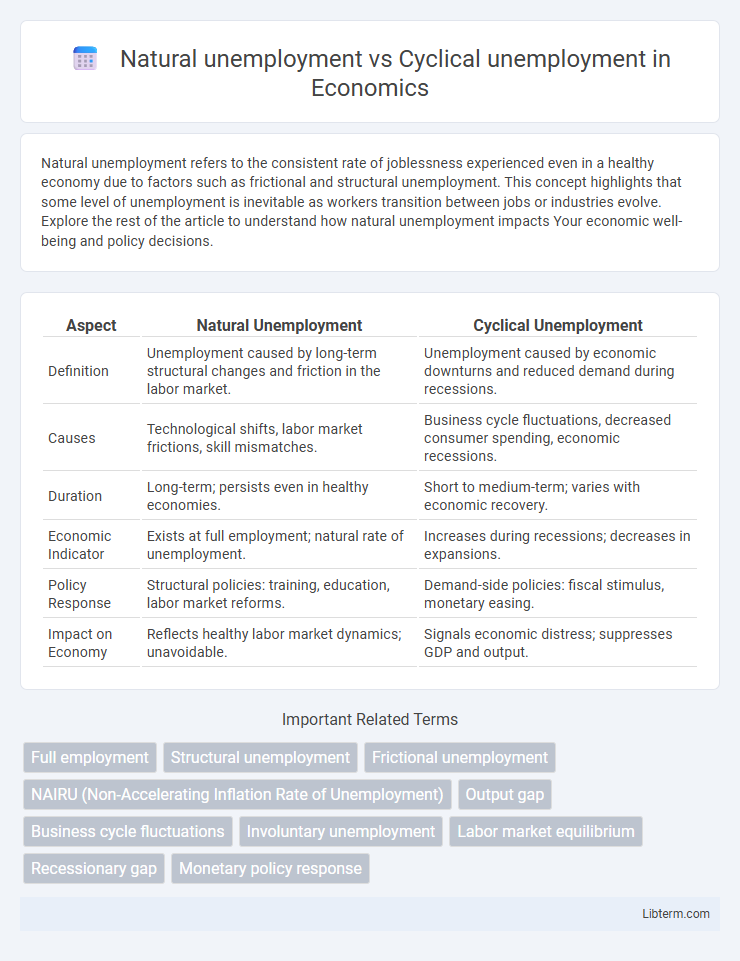Natural unemployment refers to the consistent rate of joblessness experienced even in a healthy economy due to factors such as frictional and structural unemployment. This concept highlights that some level of unemployment is inevitable as workers transition between jobs or industries evolve. Explore the rest of the article to understand how natural unemployment impacts Your economic well-being and policy decisions.
Table of Comparison
| Aspect | Natural Unemployment | Cyclical Unemployment |
|---|---|---|
| Definition | Unemployment caused by long-term structural changes and friction in the labor market. | Unemployment caused by economic downturns and reduced demand during recessions. |
| Causes | Technological shifts, labor market frictions, skill mismatches. | Business cycle fluctuations, decreased consumer spending, economic recessions. |
| Duration | Long-term; persists even in healthy economies. | Short to medium-term; varies with economic recovery. |
| Economic Indicator | Exists at full employment; natural rate of unemployment. | Increases during recessions; decreases in expansions. |
| Policy Response | Structural policies: training, education, labor market reforms. | Demand-side policies: fiscal stimulus, monetary easing. |
| Impact on Economy | Reflects healthy labor market dynamics; unavoidable. | Signals economic distress; suppresses GDP and output. |
Understanding Unemployment: Key Economic Concepts
Natural unemployment refers to the baseline level of unemployment arising from frictional and structural factors within a healthy economy, typically ranging between 4% to 6%. Cyclical unemployment fluctuates with economic cycles, increasing during recessions when demand for goods and services declines, and decreasing during periods of economic growth. Understanding the distinction between these two types helps economists design appropriate fiscal and monetary policies to stabilize the labor market and promote sustainable employment.
Defining Natural Unemployment
Natural unemployment represents the baseline level of unemployment arising from labor market frictions such as job search, skill mismatches, and voluntary transitions, existing even in a healthy economy. It encompasses structural and frictional unemployment components, reflecting normal labor market dynamics without cyclical fluctuations. Cyclical unemployment, in contrast, varies with economic downturns and recoveries, caused by insufficient demand for goods and services during recessions.
Understanding Cyclical Unemployment
Cyclical unemployment occurs when economic downturns reduce demand for goods and services, leading to job losses across multiple industries. This form of unemployment fluctuates with the business cycle and spikes during recessions, unlike natural unemployment, which encompasses frictional and structural joblessness at full economic capacity. Understanding cyclical unemployment helps policymakers design fiscal and monetary interventions to stimulate demand and restore employment levels.
Causes of Natural Unemployment
Natural unemployment occurs due to long-term structural and frictional factors within the labor market, such as skill mismatches, job search processes, and changes in technology that affect worker productivity. Causes include labor market frictions like geographic mobility constraints, imperfect information, and institutional rigidities such as minimum wage laws or union activities. Unlike cyclical unemployment caused by economic downturns and demand fluctuations, natural unemployment persists even at full employment equilibrium.
Causes of Cyclical Unemployment
Cyclical unemployment arises primarily from fluctuations in the economic cycle, where a downturn or recession reduces overall demand for goods and services, leading businesses to cut back on hiring or lay off workers. Unlike natural unemployment, which includes structural and frictional factors, cyclical unemployment directly correlates with the decline in aggregate demand and insufficient consumer spending during periods of economic contraction. Government policies such as fiscal stimulus or monetary easing are often employed to counteract cyclical unemployment by boosting demand and encouraging job creation.
Differences Between Natural and Cyclical Unemployment
Natural unemployment consists of frictional and structural unemployment, reflecting the normal job search process and mismatches in skills or locations, and it persists even in a healthy economy. Cyclical unemployment arises from fluctuations in the business cycle, increasing during economic downturns when demand for goods and services declines, leading to job losses. The key difference lies in their causes: natural unemployment is constant and related to labor market dynamics, while cyclical unemployment is temporary and directly tied to economic conditions.
Economic Impacts of Natural vs Cyclical Unemployment
Natural unemployment, comprising frictional and structural unemployment, reflects the baseline level of joblessness due to labor market adjustments and mismatches, causing minimal impact on long-term economic growth but signaling inefficiencies that can reduce potential output. Cyclical unemployment, driven by economic downturns and insufficient demand, leads to significant decreases in aggregate output and income, exacerbating recessionary conditions and reducing overall consumer spending. The economic impact of cyclical unemployment is typically more severe and requires proactive fiscal and monetary policies to stimulate demand and restore full employment.
Policy Responses to Natural Unemployment
Policy responses to natural unemployment focus on improving labor market efficiency through education and training programs that enhance workers' skills and adaptability. Structural reforms, such as reducing regulatory barriers and improving job matching services, also target frictional and structural unemployment components within the natural rate. Investment in technology and mobility incentives further facilitate workforce transitions, aiming to lower the baseline unemployment level without triggering inflationary pressures.
Policy Measures Against Cyclical Unemployment
Cyclical unemployment, caused by economic downturns, can be mitigated through expansionary fiscal policies such as increased government spending and tax cuts that boost aggregate demand. Monetary policies, including lowering interest rates and quantitative easing, stimulate investment and consumption to reduce unemployment during recessions. Unlike natural unemployment, which is influenced by structural factors, cyclical unemployment responds directly to these short-term macroeconomic interventions.
Long-Term Implications for Labor Markets
Natural unemployment, comprising frictional and structural unemployment, represents the baseline level of joblessness inherent in a healthy labor market and typically stabilizes over the long term. Cyclical unemployment arises from economic downturns and fluctuating demand, causing temporary job losses that usually decline as the economy recovers. Persistent high cyclical unemployment can lead to skill degradation and discourage labor force participation, weakening long-term labor market efficiency and growth potential.
Natural unemployment Infographic

 libterm.com
libterm.com